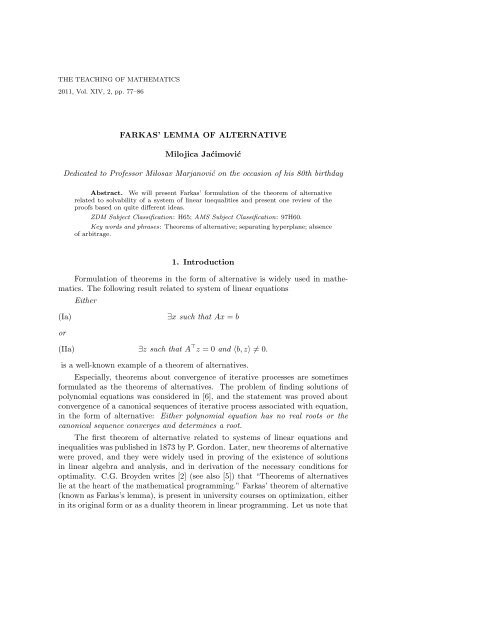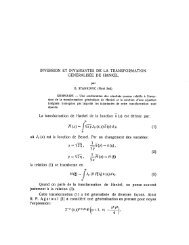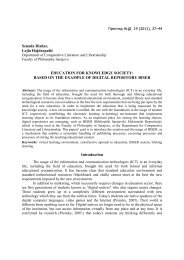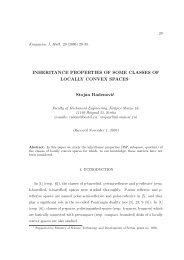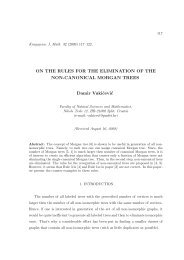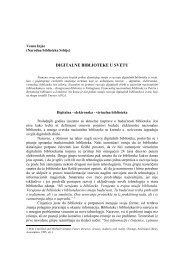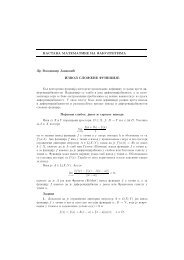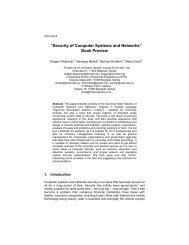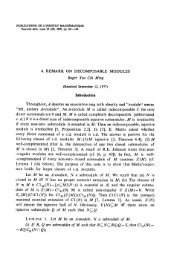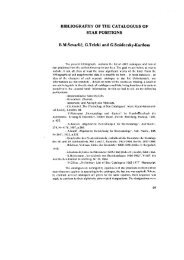FARKAS' LEMMA OF ALTERNATIVE Milojica Jacimovic Dedicated ...
FARKAS' LEMMA OF ALTERNATIVE Milojica Jacimovic Dedicated ...
FARKAS' LEMMA OF ALTERNATIVE Milojica Jacimovic Dedicated ...
Create successful ePaper yourself
Turn your PDF publications into a flip-book with our unique Google optimized e-Paper software.
THE TEACHING <strong>OF</strong> MATHEMATICS<br />
2011, Vol. XIV, 2, pp. 77–86<br />
FARKAS’ <strong>LEMMA</strong> <strong>OF</strong> <strong>ALTERNATIVE</strong><br />
<strong>Milojica</strong> Jaćimović<br />
<strong>Dedicated</strong> to Professor Milosav Marjanović on the occasion of his 80th birthday<br />
Abstract. We will present Farkas’ formulation of the theorem of alternative<br />
related to solvability of a system of linear inequalities and present one review of the<br />
proofs based on quite different ideas.<br />
ZDM Subject Classification: H65; AMS Subject Classification: 97H60.<br />
Key words and phrases: Theorems of alternative; separating hyperplane; absence<br />
of arbitrage.<br />
1. Introduction<br />
Formulation of theorems in the form of alternative is widely used in mathematics.<br />
The following result related to system of linear equations<br />
Either<br />
(Ia) ∃x such that Ax = b<br />
or<br />
(IIa) ∃z such that A ⊤ z = 0 and 〈b, z〉 = 0.<br />
is a well-known example of a theorem of alternatives.<br />
Especially, theorems about convergence of iterative processes are sometimes<br />
formulated as the theorems of alternatives. The problem of finding solutions of<br />
polynomial equations was considered in [6], and the statement was proved about<br />
convergence of a canonical sequences of iterative process associated with equation,<br />
in the form of alternative: Either polynomial equation has no real roots or the<br />
canonical sequence converges and determines a root.<br />
The first theorem of alternative related to systems of linear equations and<br />
inequalities was published in 1873 by P. Gordon. Later, new theorems of alternative<br />
were proved, and they were widely used in proving of the existence of solutions<br />
in linear algebra and analysis, and in derivation of the necessary conditions for<br />
optimality. C.G. Broyden writes [2] (see also [5]) that “Theorems of alternatives<br />
lie at the heart of the mathematical programming.” Farkas’ theorem of alternative<br />
(known as Farkas’s lemma), is present in university courses on optimization, either<br />
in its original form or as a duality theorem in linear programming. Let us note that
78 M. Jaćimović<br />
Farkas’ lemma can be interpreted as a finite-dimensional version of Hahn-Banach<br />
theorem.<br />
In this paper, in Section 2, we give five different proofs of the theorem of alternative.<br />
The proof connected with separation theorem is based on geometrical<br />
interpretation of the theorem and it is probably the shortest and the most popular.<br />
However, it cannot be considered as an “elementary proof”, because some “topological<br />
arguments” (though simple) are used in it. In the second proof the so-called<br />
Fourier-Motzkin’s method of elimination [3] is used which can be considered as a<br />
particular case of the well-known Tarski’s theorem on quantifier elimination. This<br />
interesting method can in principle be used for construction of theorem provers,<br />
but the volume of computing grows too fast with dimension of the problem.<br />
The proof by induction of the Farkas’ lemma is infrequent in literature. Method<br />
o induction was used in [1] for proving of one generalization of Farkas’ lemma. Here,<br />
we follow this proof.<br />
The fourth proof which belongs to C.G. Broyden [2] is also algebraic. Namely,<br />
Broyden proved one property of orthogonal matrices from which Farkas’s lemma<br />
can be derived.<br />
Finally, let us note that Farkas’s lemma has been applied to different problems<br />
in economics. We also present one such application, because it can contribute to<br />
understanding of this lemma.<br />
2. Farkas’ lemma<br />
We will begin with formulation of one statement known as Farkas’ lemma.<br />
Teorema 1. (Farkas’ lemma) Let A be a matrix of order m × n and b a<br />
vector-column of dimension m. Then either<br />
(I) ∃x ≥ 0 such that Ax = b<br />
or<br />
(II) ∃z such that A ⊤ z ≤ 0 and 〈b, z〉 > 0.<br />
It is clear that (II) is equivalent to<br />
(II’) ∃z such that A ⊤ z ≥ 0 and 〈b, z〉 < 0.<br />
G. Farkas was a professor of Theoretical physics at the University of Kolozsvar<br />
(Hungary). He obtained this result while he was solving the problem of mechanical<br />
equilibrium posed by J. Fourier in 1798. He published it for the first time in 1898 in<br />
Hungarian, but Farkas’ best-known exposition of his famous lemma was published<br />
in German in 1902.<br />
If we denote the vectors-columns of matrix A by a 1 , a 2 , . . . , a n , we obtain an<br />
equivalent form of this theorem.
Farkas’ lemma of alternative 79<br />
The inequality 〈b, z〉 ≥ 0 is a consequence of the system of inequalities<br />
〈a 1 , z〉 ≥ 0, 〈a 2 , z〉 ≥ 0, . . . , 〈a m , z〉 ≥ 0<br />
if and only if vector b is a linear combination<br />
b = x1a 1 + x2a 2 + · · · + xna n<br />
with nonnegative coefficients x1, x2, . . . , xn.<br />
Farkas’s lemma shows that non-solvability of the system can be “certified”:<br />
the solution z of (II) can be used as a “certificate” that the system (I) cannot be<br />
solved. Such certificates in mathematics are called obstructions.<br />
There are several generalizations of Farkas’ lemma. A part of these generalizations<br />
is related to the solvability of linear equation systems in other sets (besides<br />
R n +). For example, the following theorem gives a criterion of solvability of linear<br />
equation systems in integers.<br />
Theorem 2. Let A be a rational matrix and b a rational column vector. Then<br />
either<br />
system Ax = b has an integer solution,<br />
or<br />
∃y such that A ⊤ y is an integer and 〈b, y〉 is not an integer.<br />
3. Proofs of Farkas’ lemma<br />
There are several variants of theorems of alternative and a lot of their proofs.<br />
Here, we will present some of the proofs of Farkas’s lemma.<br />
We will separately prove that the systems (I) and (II) are not solvable simultaneously.<br />
Assume the contrary, that there exist x0 ∈ R n and z0 ∈ R m that are<br />
solutions to (I) and (II) respectively. Then, we have<br />
0 = 〈x0, 0〉 = 〈x0, A ⊤ z0〉 = 〈Ax0, z0〉 = 〈b, z0〉 > 0.<br />
Thus, we arrive at a contradiction, and the first part of Farkas’s lemma is proved.<br />
Now, we will present some proofs of the second part of Farkas’s lemma.<br />
Proof 1. Let us suppose that the system (I) has no solution. Then b /∈ C :=<br />
{Ax : x ≥ 0}. The set C is convex and closed, so by the separation theorem of<br />
closed convex sets, there exists a hyperplane H := {x : 〈z, x〉 = α} containing b<br />
(α = 〈z, b〉) such that<br />
(∀y ∈ C) 〈z, y〉 < α ⇒ (∀x ∈ R n +) 〈A ⊤ z, x〉 < α.<br />
This inequality is possible only for α > 0 and A ⊤ z ≤ 0. So, we conclude that there<br />
exists z ∈ R m , satisfying (II).<br />
Let us remark that in this very short and elegant geometric proof, the proof<br />
that the set C := {Ax : x ≥ 0} is closed was omitted. In addition, separation
80 M. Jaćimović<br />
theorem is intuitively acceptable, but its proof is not so easy. These two facts are<br />
the most sensitive part of the geometrical proof of the theorem of alternative.<br />
Note also that the existence of separating hyperplane for the set C and b /∈ C<br />
can be derived as a consequence of Farkas’ lemma. It means that there is a ball<br />
B(b, r) such that C ∩ B(b, r) = ∅ and C is a closed set.<br />
Instead of the separation theorem, one can use in this proof some properties<br />
of the projection on a convex closed set. Namely, if there is no x ∈ R n + such that<br />
Ax = b, then there is a unique point u = Ay = πC(b), where πC(b) is the projection<br />
of b on C. The key property of the projection gives:<br />
Let us put z = b − u = −Ay + b. Then,<br />
〈b − Ay, Ax − Ay〉 ≤ 0 for all x ≥ 0.<br />
〈x − y, A ⊤ z〉 ≤ 0, for all x ≥ 0.<br />
From here, for x = y + ei ≥ 0, where e1, e2, . . . , en is the standard basis of R n , we<br />
have that the i-th component (A ⊤ y)i of A ⊤ y is nonpositive, i.e. A ⊤ z ≤ 0. Besides,<br />
and<br />
〈z, u〉 = 〈z, Ay〉 = 〈−Ay + b, Au〉 = 〈b − Ay, Au − Ax〉 ≥ 0,<br />
〈b, z〉 = 〈u + z, z〉 = 〈u, z〉 + 〈z, z〉 > 0.<br />
In [4], the proof of existence of the projection of b on C was given by introducing<br />
a simple iterative algorithm. Then the closedness of set C can be derived as an<br />
immediate consequence of the existence of projection of any point b ∈ ∞R n on C.<br />
Hence, Dax’s proof can be considered as an indirect proof of the closedness of set<br />
C.<br />
Proof 2. In this proof (see [3]) the so-called Fourier-Motzkin method for elimination<br />
of variables in linear inequalities will be used. This method can be considered<br />
as a particular case of Tarski’s quantifier elimination theorem. It can be used for<br />
building of a theorem provers for this case. But, even in the case of a system of<br />
linear inequalities with only existential quantifiers, the method has very fast growth<br />
of the number of computational operation.<br />
Denote by a1, a2, . . . , am and a 1 , a 2 , . . . , a n the rows and the columns of matrix<br />
A = (aij)m×n. Then, system (II) can be written in the form<br />
〈a 1 , z〉 ≥ 0, 〈a 2 , z〉 ≥ 0, . . . , 〈a n , z〉 ≥ 0, 〈a n+1 , z〉 ≤ −β < 0,<br />
where vector b is denoted by a n+1 .<br />
For example, suppose that we wish to eliminate the variable z1 from the above<br />
system. Let us denote I + = {i : a1i > 0}, I − = {i : a1i < 0}, I 0 = {i : a1i = 0}.<br />
The new system of inequalities will be constructed using the following rules.<br />
For each pair (k, l) ∈ I + × I − let us multiply the inequalities 〈a k , z〉 ≤ 0 and<br />
〈a l , z〉 ≤ 0 by −a1l > 0 and a1k > 0, respectively. Adding these two inequalities,
Farkas’ lemma of alternative 81<br />
we obtain a new one that does not contain the variable zl. All inequalities obtained<br />
in this way will be added to those already in I0. If I + (or I − ) is empty, we simply<br />
delete inequalities with indices in I − (or in I + ). The inequalities with indices in I0<br />
form a new system of linear inequalities Bz ′ ≤ d, z ′ = (z2, . . . , zn). The procedure<br />
of elimination of variable z1 is described.<br />
Let us remark that if z ′ = (z ′ 2, . . . , z ′ n) is a solution of the system Bz ′ ≤ d, and<br />
max<br />
l∈I− al1 −1 (− n<br />
alj + bl) ≤ z1 ≤ min<br />
j=2<br />
k∈I + ak1 −1 ( n<br />
akj − bk)<br />
j=2<br />
then z = (z1, z ′ ) = (z1, z2, . . . , zn) is a solution of the system (II).<br />
Suppose that the system (II): A⊤z ≤ 0, 〈−b, z〉 ≤ −β < 0 has no solution.<br />
Applying Fourier-Motzkin method for the elimination of the variables z1, z2, . . . , zn,<br />
one obtains a system of inequalities without variables, that is a contradiction. This<br />
procedure converts the system (II) in inconsistent system<br />
<br />
⊤ A<br />
( R q )<br />
−b⊤ <br />
= ( R q ) ( 0 −β ) ,<br />
with β > 0 and nonnegative elements of the matrix (R q). It means that RA ⊤ −<br />
qb t = 0, where at least one qi = 0. Consequently, there is x ≥ 0 such that<br />
Ax − b = 0.<br />
Proof 3. The proof by induction is the third that will be presented here. In<br />
spite of its simplicity, this proof is quite infrequent in literature. We will expose<br />
this proof by following the proof of a generalization of Farkas’ lemma from [1].<br />
For n = 1 the systems (I) and (II) have the following form<br />
and the statement is obviously valid.<br />
∃x ∈ R+ such that ax = b (a, b ∈ R m<br />
∃z ∈ R m such that 〈a, z〉 ≤ 0 and 〈b, z〉 > 0.<br />
Let us assume that the statement is valid for all natural n and let us consider<br />
m-dimensional vectors a 1 , a 2 , . . . , a n , a n+1 . We have to prove that: (I) there exist<br />
nonnegative real numbers x1, x2, . . . , xn, xn+1 such that b = x1a 1 + · · · + xna n +<br />
xn+1a n+1 or (II) there exists z ∈ R m such that 〈a 1 , z〉 ≤ 0, . . . , 〈a n , z〉 ≤ 0,<br />
〈a n+1 , z〉 ≤ 0, 〈b, z〉 > 0.<br />
By induction hypothesis, we have that: (i) there exist nonnegative real numbers<br />
x1, x2, . . . , xn such that b = x1a 1 + · · · + xna n or (ii) there exists z ∈ R m such that<br />
〈a 1 , z〉 ≤ 0, . . . , 〈a n , z〉 ≤ 0, 〈b, z〉 > 0. In case (i) it is enough to put xn+1 = 0<br />
and we will obtain that (I) is valid. In case (ii), we will consider two possibilities:<br />
(ii-1) 〈a n+1 , z〉 ≤ 0 and then we obtain that (II) is valid.<br />
So, it remains to consider the case when there exists z = z ∈ R m such that<br />
〈a 1 , z〉 ≤ 0, . . . , 〈a n , z〉 ≤ 0, 〈b, z〉 > 0 but 〈a n+1 , z〉 > 0. Let us consider two<br />
systems<br />
(A) 〈a 1 , z〉 ≤ 0, . . . , 〈a n , z〉 ≤ 0, 〈a n+1 , z〉 ≤ 0, 〈b, z〉 > 0.
82 M. Jaćimović<br />
and<br />
(B) 〈a 1 , z〉 ≤ 0, . . . , 〈a n , z〉 ≤ 0, 〈a n+1 , z〉 = 0, 〈b, z〉 > 0.<br />
Each solution of (B)is a solution of (A). Further, if z is a solution of (A) then z + z<br />
is a solution of (B). Hence, (A) has a solution (in this case (II) is valid) if and only<br />
if (B) has a solution.<br />
Now, let us consider vectors c i = a i −λia n+1 , i = 1, 2, . . . , n and b ′ = b−µa n+1<br />
where λi = 〈ai ,z〉<br />
〈a n+1 ,z〉<br />
has a solution if and only if system<br />
〈b,z〉<br />
≤ 0 and µ = 〈an+1 ,z〉 > 0. It is easy to see that the system (B)<br />
(C) 〈c 1 , z〉 ≤ 0, . . . , 〈c n , z〉 ≤ 0, 〈a n+1 , z〉 = 0, 〈b ′ , z〉 > 0.<br />
has a solution. So, we have to concern the system (B).<br />
Using the induction hypothesis again, we have that: (j) there exist nonnegative<br />
real numbers y1, y2, . . . , yn such that b ′ = y1c 1 +· · ·+ync n or (jj) there exists u ∈ R m<br />
such that 〈c 1 , u〉 ≤ 0, . . . , 〈c n , u〉 ≤ 0, 〈b ′ , u〉 > 0. In case (jj), we have that the<br />
vector z = u − γz where γ = 〈b,u〉<br />
〈an+1 ,z〉 , is a solution of (C) and consequently (II) is<br />
valid.<br />
If there exist nonnegative real numbers y1, y2, . . . , yn such that b ′ = y1c 1 +<br />
· · · + ync n (case (jj)), then<br />
b ′ = b − µa n+1 = y1c 1 + · · · + ync n = y1a 1 − λ1y1a n+1 + · · · + yna n − λnyna n+1 .<br />
Hence,<br />
b = y1a 1 + · · · + yna n + yn+1a n+1<br />
where y1, y2, . . . , yn and yn+1 = µ − λ1y1 − · · · − λnyn ≥ 0. It maens that (I) is<br />
valid.<br />
The fourth proof appeared in G. Broyden’s paper [2]. It is based on one<br />
property of orthogonal matrices that is referred as a Broyden’s theorem.<br />
Broyden’s theorem. If Q = (qij)n×n is an orthogonal matrix, then there<br />
exists a vector x > 0 and a unique diagonal matrix S = diag(s1, s2, . . . , sn) such<br />
that si = ±1 and SQx = x.<br />
The Broyden’s proof of this theorem is by induction. For m = 1 the theorem<br />
is trivially true (Q and S are both equal to either +1 or −1). Assume the theorem<br />
is true for all orthogonal matrices of order m × m. Let Q = (qij) (m+1)×(m+1) be an<br />
orthogonal matrix and let<br />
Q =<br />
<br />
P r<br />
qt <br />
,<br />
α<br />
where P = (pij)m×m. If α = 1 or α = −1, then r = q = 0 and the step induction<br />
becomes trivial. So, in what follows we can assume that |α| < 1. Since Q is an<br />
orthogonal matrix,<br />
P ⊤ P + q ⊤ q = I, P ⊤ r + αq = 0, r ⊤ r + α 2 = 1.
It follows from these equations that the matrices<br />
Farkas’ lemma of alternative 83<br />
Q1 = P − rq⊤<br />
α − 1 , Q1 = P − rq⊤<br />
α + 1<br />
are orthogonal and that<br />
Q ⊤ 2<br />
2 Q1 = I − q<br />
1 − α2 q⊤ .<br />
Using induction assumption we conclude that there are x1 > 0 and x2 > 0 and<br />
diagonal sign matrices S1 and S2 such that S1Q1x1 = x1, S2Q2x2 = x2. From this<br />
we obtain that<br />
〈S1x1, S2x2〉 = 〈Q1x1, Q2x2〉 = 〈Q ⊤ 2 Q1x1, x2〉 = 〈x1, x2〉 − 2<br />
1 − α 2 〈x1, q〉〈x2, q〉.<br />
Now, we have to consider two cases.<br />
Case 1. If S1 = S2, then 〈S1x1, S2x2〉 < 〈x1, x2〉. So, 〈q, x1〉 = 0 and 〈q, x2〉 =<br />
0 and both scalar products have the some signs. For<br />
−〈q, x1〉<br />
η1 =<br />
α − 1 , η2<br />
−〈q, x2〉<br />
=<br />
α + 1 , z1<br />
<br />
x1<br />
x2<br />
= , z2 = ,<br />
η1<br />
−η2<br />
S 1 <br />
S1 0<br />
= , S<br />
0 1<br />
2 <br />
S2 0<br />
=<br />
,<br />
0 −1<br />
we have<br />
Qz1 = S 1 z1, Qz2 = S 2 z2.<br />
Now, since |α| < 1, and both scalar products 〈q, xi〉 have the same signs, one of ηi<br />
is positive and one of the vectors z1 and z2 is the required vector. In case 1 the<br />
proof is completed.<br />
Case 2. If S1 = S2, then 〈S1x1, S2x2〉 = 〈x1, x2〉 and at least one of 〈q, x1〉 and<br />
〈q, x2〉 is zero. We will assume that 〈q, x1〉 = 0 and 〈q, x2〉 = 0. So P x1 = S1x1 =<br />
Q1x1 and Qz1 = S1z1, where<br />
<br />
x1<br />
z1 = , S<br />
0<br />
1 <br />
S1 0<br />
= , σ = ±1 may be chosen arbitrarily.<br />
0 σ<br />
Now, if we rewrite Q in the form<br />
Q =<br />
α1 q ⊤ 1<br />
r1 P1<br />
where P1 is a matrix of the type m × m, and repeat the previous argument, we will<br />
obtain that there exist a positive vector x2 and a diagonal matrix S2 with ±1 on<br />
diagonal, such that<br />
Qz2 = S 2 <br />
0<br />
z2, z2 =<br />
x2<br />
<br />
<br />
, S 2 =<br />
where σ ′ = ±1, σ = ±1 may be chosen arbitrarily.<br />
0 σ ′<br />
S1 0<br />
<br />
,
84 M. Jaćimović<br />
Combining the equation Qz1 = S 1 z1 and Qz2 = S 2 z2, we obtain<br />
Q(z1 + z2) = S 1 z1 + S 2 z2,<br />
with strictly positive coordinate z1j and z2j for j ≥ 2. If for some j ∈ {2, . . . , m} the<br />
corresponding diagonal elements of S 1 and S 2 are different, then S 1 z1 + S 2 z2 <<br />
z1+z2 = Q(z1+z2), but it is a contradiction with the previous equality. We can<br />
choose the elements σ and σ ′ so that S 1 = S 2 . So, we have Q(z1+z2) = S 1 (z1+z2),<br />
and since z1+z2 is strictly positive and S 1 is a diagonal matrix with ±1 on diagonal,<br />
this establishes the induction in case S1 = S2.<br />
Assume that there exist two positive vectors x and y and two diagonal matrices<br />
S and R with ±1 on diagonal, such that Qx = Sx = Ry, and S = R. Then<br />
〈x, y〉 = 〈Qx, Qy〉 = 〈Sx, Ry〉 < 〈x, y〉,<br />
giving a contradiction. Therefore, R = S. This completes the proof of Broyden’s<br />
theorem.<br />
The next result known as Tucker’s theorem is a simple consequence of Broyden’s<br />
theorem.<br />
Tucker’s theorem. Let A be a skew-symmetric matrix. Then there exists<br />
y ≥ 0 such that Ay ≥ 0 and y + Ay > 0.<br />
Proof. Since A is skew-symmetric then (I + A) −1 (I − A) is orthogonal, so that<br />
there exist a positive vector x and a unique matrix S such that<br />
(I − A) −1 (I + A)x = Sx ⇔ x + Ax = Sx − ASx.<br />
If we denote y = x + Sx, z = Ay = Ax + ASx = x − Sx, then every coordinate<br />
yj of vector y is equal either 2xj or zero, so y ≥ 0. Similarly, z ≥ 0. But y + z =<br />
y + Ay = 2x > 0.<br />
Proof 4. (Broyden’s proof of Farkas’s lema) Apply Tucker’s theorem to skewsymmetric<br />
matrix<br />
⎛<br />
O O A<br />
⎞<br />
−b<br />
⎜<br />
B = ⎝<br />
O O −A b ⎟<br />
⎠<br />
−A ⊤ A ⊤ O 0<br />
b ⊤ −b ⊤ O ⊤ 0.<br />
By Tucker’s theorem, there exists a positive vector y = (z1, z2, x, t) ⊤ such that<br />
y + By > 0. Consider the two cases: t > 0 and t = 0 with z = z1 − z2. If t > 0 the<br />
vector y may be normalized so that t = 1, from which we obtain Ax = b. If t = 0<br />
then A ⊤ z ≤ 0 and 〈b, z〉 > 0.<br />
In his paper Broyden discussed the question of relation between Tucker’s theorem,<br />
Farkas’s lemma and Broyden’s theorem. He derived Tucker’s theorem and<br />
Farkas’s lemma as simple consequences of Broyden’s theorem. In [7] Ross and<br />
Terlaky showed that Broyden theorem is also a simple consequence of Tucker’s theorem<br />
and Farkas’s lemma. It means that Farkas’s lemma, Tucker’s theorem and<br />
Broyden’s theorem are equivalent results.
Farkas’ lemma of alternative 85<br />
In [7], the following observation was made: for a given orthogonal matrix Q<br />
the existence of a unique diagonal matrix S with diagonal elements sii = ±1 and<br />
positive vector x such that Qx = Sx is equivalent to the existence of a positive<br />
vector x such that<br />
|Qx| = x, x > 0 ⇔ −x ≤ Qx ≤ x, x > 0,<br />
where |y| denotes the vector whose entries are absolute values of the entries of<br />
vector y. So, if one finds a vector x satisfying the previous conditions, then sii = 1<br />
if xi > 0 and sii = −1 if xi < 0.<br />
This Roos’ and Terlaky’s comment was a very perspicuous answer on Broyden’s<br />
remark [2] that “However, it may yet be possible to construct such algorithm (for<br />
determining of the sign of a matrix) and the author suspects that if this is the case<br />
then any successful example would have more than a passing resemblance to the<br />
interior point algorithms, but only the passage of time will resolve this conjecture”.<br />
3. An example of economic interpretation of Farkas’ lemma<br />
Let us consider a market in which m different assets are traded. Suppose that<br />
there are n possible states of market at the end of the period. Let us denote by<br />
p1, p2, . . . , pm the given prices at the beginning of the period. Let A = (aij)m×n be<br />
a payoff matrix, where aij denote the price of i-th asset at the end of the period, if<br />
the market is in state j. A portfolio of assets is then a vector x = (y1, y2, . . . , ym),<br />
where yi denotes the amount of i-th asset. If the component yi is positive, then<br />
the investor which bought yi units of i-th asset will receive ajiyi if j-th state<br />
materializes. But, one supposes that sell short position is allowed, that means<br />
selling some quantity of i-th asset at the beginning of the period and buying it<br />
back at the end. Consequently, yi can be negative. In this case one must pay out<br />
aji|yi|.<br />
At the end of the period the investor with portfolio y = (y1, y2, . . . , y ) will receive<br />
z = A⊤y, where zj = n i=1 ajiyi is a result from portfolio y = (y1, y2, . . . , yn)<br />
in the state j. The cost of acquiring a portfolio x is given by 〈p, y〉. In asset pricing<br />
the main problem is to determine the prices pi. In arbitrage pricing theory, the<br />
standard condition is the absence of arbitrage: there is no portfolio with a negative<br />
cost but a positive return in every state. This principle can be formulated as<br />
or as<br />
if A ⊤ y ≥ 0 then 〈p, y〉 ≥ 0<br />
there is no y such that A ⊤ y ≥ 0, 〈p, y〉 < 0.<br />
It means that only certain prices p are consistent with principle of absence of<br />
arbitrage. Here we have new question: how to describe these prices? The answer<br />
is contained in the following variant of Farkas’ lemma.<br />
Theorem 3. The absence of arbitrage condition holds if and only if there<br />
is a nonnegative vector q ∈ R n + such that the prices of assets are given by pi =<br />
m<br />
j=1 ajiqj.
86 M. Jaćimović<br />
Let us comment the above theorem. If the absence of arbitrage condition holds,<br />
then the system Ay ≥ 0, 〈p, y〉 < 0 has no solutions. Now, from Farkas’ lemma<br />
we derive the existence of vector q ∈ Rn , such that p = Aq. Then for p∗ = p <br />
i qi<br />
and q∗ = q we obtain the equality in scaled prices: p∗ = Aq∗ . Further, vector<br />
i qi<br />
q ∗ can be interpreted as a vector of distribution of probabilities. Hence, there is<br />
a distribution of probabilities under which the expected return of every asset is<br />
equal to its price. These probabilities are called risk-neutral probabilities. Hence,<br />
Farkas’ lemma can be formulated as: the existence of risk-neutral probabilities is a<br />
consequence of the absence of arbitrage condition.<br />
REFERENCES<br />
[1] D. Bartl, A short algebraic proof of the Farkas’ lemma, SIAM J. Optim, 19, 1, 234–239.<br />
[2] C.G. Broyden, A simple algebaric proof of Farkas’s lemma and related theorems, Optim.<br />
Methods and Software, 8, 3-4 (1988), 185–199.<br />
[3] V.Chandru, C. Lassez, J.L. Lassez, Qualitative theorem proving in linear constraints, in book:<br />
Verification: Theory and Practice, Lecture notes in computer science, Springer, Berlin/Heidelberg,<br />
2004, pp. 395–406.<br />
[4] A. Dax, An elementary proof of Farkas’ lema, SIAM Rev. 39, 3 (1997), 503–507.<br />
[5] Yu.G. Evtushenko, A.I. Golikov, New perspective on the theorems of alternative, in book:<br />
High Performance Algorithms and Software for Nonlinear Optimization, Kluwer Academic<br />
Publishers, 2002, pp. 223–237.<br />
[6] M.M. Marjanović, An iterative method for solving polynomial equations, Topology and its<br />
applications, Budva 1972, 170–172.<br />
[7] C. Roos, T. Terlaky, Note on a paper of Broyden, Operations Research Letters, 25, 4 (1999),<br />
183–186.<br />
Department of Mathematics, University of Montenegro, Podgorica


